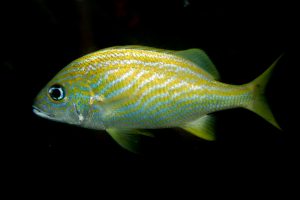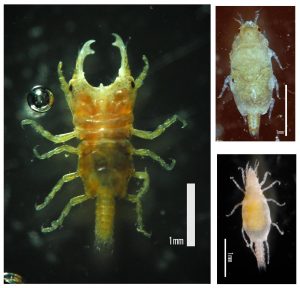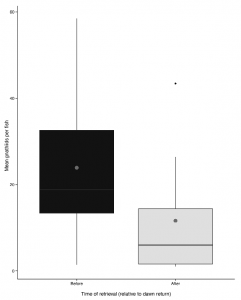Nocturnal migration reduces exposure to micropredation in a coral reef fish
By Josh Ratay, SRC intern

The French grunt was used as the organism of study, though gnathiid isopods feed on many different species of reef fish. Image from Wikimedia Commons.
Nocturnal migration reduces exposure to micropredation in a coral reef fish is a new study examining daily migrations of French grunt (Haemulon flavolineatum) and the exposure to parasitic isopods. French grunts are known to move off the reefs and into seagrass beds at night. Such behavior in animals is usually attributed to increased availability of prey or decreased exposure to predators. However, this study investigates the idea that the fish’s movements may serve as a method of avoiding isopods, which are far more common on the reefs than in seagrass communities.
The French grunt served as an ideal model organism for this study since it is both extremely common and well-studied on Caribbean reefs. However, many other reef fish are known to undertake similar nightly migrations away from the reef. Gnathiid isopods are tiny parasitic crustaceans which attach to fish and feed on blood. Though they usually hide in reef sediments, the larvae emerge to find a short-term host fish directly before molting and growth. Though far smaller than their hosts, these parasites can have many negative health impacts on fish, including decreased concentrations of red blood cells, tissue damage and infection, and even the death of juvenile fish which are exposed to a high isopod load.

Larval gnathiid isopods (bottom right) feed on the blood of fish before molting. Adult males (left) and females (right) tend to remain in the sediment. Image from Wikimedia Commons.
In this study, several tests were performed at different locations in the Caribbean to test the hypothesis that leaving the reef at night results in fewer numbers of isopods infesting French grunts. Cages containing 5 to 8 fish were deployed overnight at both reefs and nearby seagrass habitats where grunts had been observed. Also, the exact arrival times (around dawn) of the wild grunts to the reefs were observed at different sites, and cages of grunts were subsequently placed at the reefs for both the 30 minutes preceding the arrival time and 30 minutes following the arrival time. The goal of this test was to investigate whether or not the fish’s arrival time coincided with lessened isopod activity. Additional cages were also deployed to test day versus night isopod levels, and the whether or not juvenile grunts were also susceptible to isopod infestation. All fish from the cages were placed in seawater tanks, where the isopods naturally detached and were then counted.

Box and whisker plot showing the decrease in isopods in the time after the fish have returned to the reef vs. immediately before. Figure from Sikkel et al 2017.
Statistical analysis of the data revealed that grunts which spent the night on the reefs contracted 3 to 44 times as many isopods as those which were left in the seagrass bed. Fish which were placed on the reefs during the 30 minutes before the return time of the wild grunts contained twice as many isopods as those which were exposed to the reef after the return time. Nighttime isopod load on the reefs was also much higher than the daytime load, and isopods were detected on juveniles from the reefs but not the seagrass beds. Overall, these results were significant and suggest that moving to seagrass beds at night is an effective method of isopod evasion for both adult and juvenile grunts, and that the fish return in the morning as isopods become less active. The results from this study suggest that further research is needed into the potential for parasites to drive movements of coral reef organisms.
Works cited
Sikkel, P. C., Welicky, R. L., Artim, J. M., McCammon, A. M., Sellers, J. C., Coile, A. M., & Jenkins, W. G. (2016). Nocturnal migration reduces exposure to micropredation in a coral reef fish. Bulletin of Marine Science.
